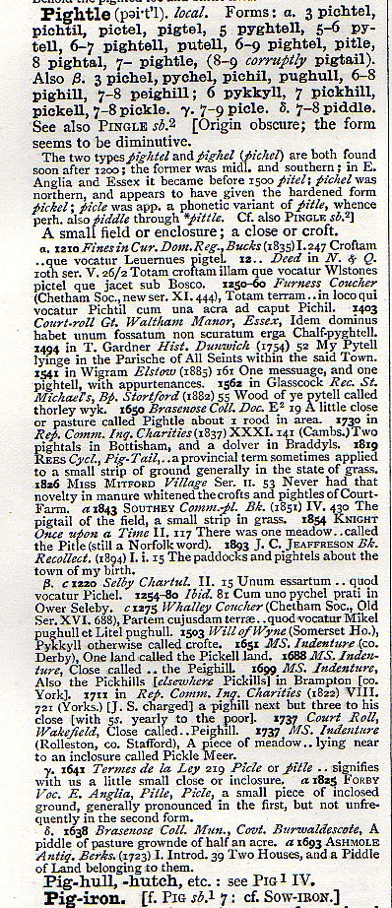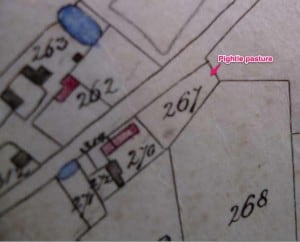Whilst on our walk today we came across this farm with the name The Pightle, Larry and I were fascinated by the origin of the name so out came the iPhone and a quick search on wiktionary revealed:-
“Odd-shaped fields now caused problems which had not been encountered in the days before mechanization. Thus, over several years, fields were reorganized to be acceptably rectangular.This was cleverly and thoughtfully arranged but,inevitably, there were remnants, leftovers,off-cuts or tailings. In most cases, these were small pieces of land,which were essentially triangular in shape. The locals probably referred to these pieces as “pigtails”. In Norfolk dialect,this would quickly become pronounced as “pightle”. In the 1920’s through the 1940’s,the word pightle was in fairly common usage but has fallen into disuse in recent years.”

Once at home I was able to consult my 1909 first edition of the complete English Dictionary. this had the following entry:-
So there we have it an old East Anglian word dating from 1200 meaning a small piece of enclosed land.
Thanks to Rosemary, one of my readers, I now have a section from an enclosure map for Westhorpe, Suffolk the map was dated 1840 and is showing a pightle.

Just googled pightle to find out what it was as the 1900 OS map of Nettlebed, Oxfordshire has ‘Broom Pightles’ and ‘Cordery’s Pightle’.
This is really interesting. Have noticed Pightle all over my area of mid Suffolk and wondered about it. Looked this up because I have been doing some work on an 1840 Tithe map of our village and pightle appears several times. Thanks for the research.
New blog post: Word of the day – Pightle http://t.co/ptt3zXlY
Here it is a long way from Norfolk.
Attested copies of lease and release, 2/3 Mar 1778. ACC/0173/015 1814
Related information: [see also ACC/0173/007 and ACC/0173/016]
Contents:
1. Dulcibella Darby of Sunbury, widow.
2. Charles Meniconi.
Premises: farm, messuages, barns, lands and tenements at Halliford now in occupation of James Ballingham, jun. (unspecified); all lands at Halliford now in occupation of Widow Cane (unspecified); cottage at Halliford [Sunbury] with garden and orchard now empty; three little pightles near River Thames opposite late Sir Edward Turner’s house at Sunbury; other lands at Sunbury partly enclosed in occupation of Mrs Trott; farm and messuage near Ashford late in occupation of John Palmer; farm near Staines in occupation of William Cooper; messuage in Dover Street, Piccadilly [St. James Westminster] now in occupation of Lady Elizabeth Worsley; messuage in Oxford; other farms and lands in Surrey and Berkshire and all appurts.
http://www.nationalarchives.gov.uk/A2A/records.aspx?cat=074-acc173&cid=-1#-1
Hi George,Many thanks for your comment, interesting that the word is in use near the River Thames which was probably the main highway to East Anglia prior to the railways. So maybe not so far 🙂